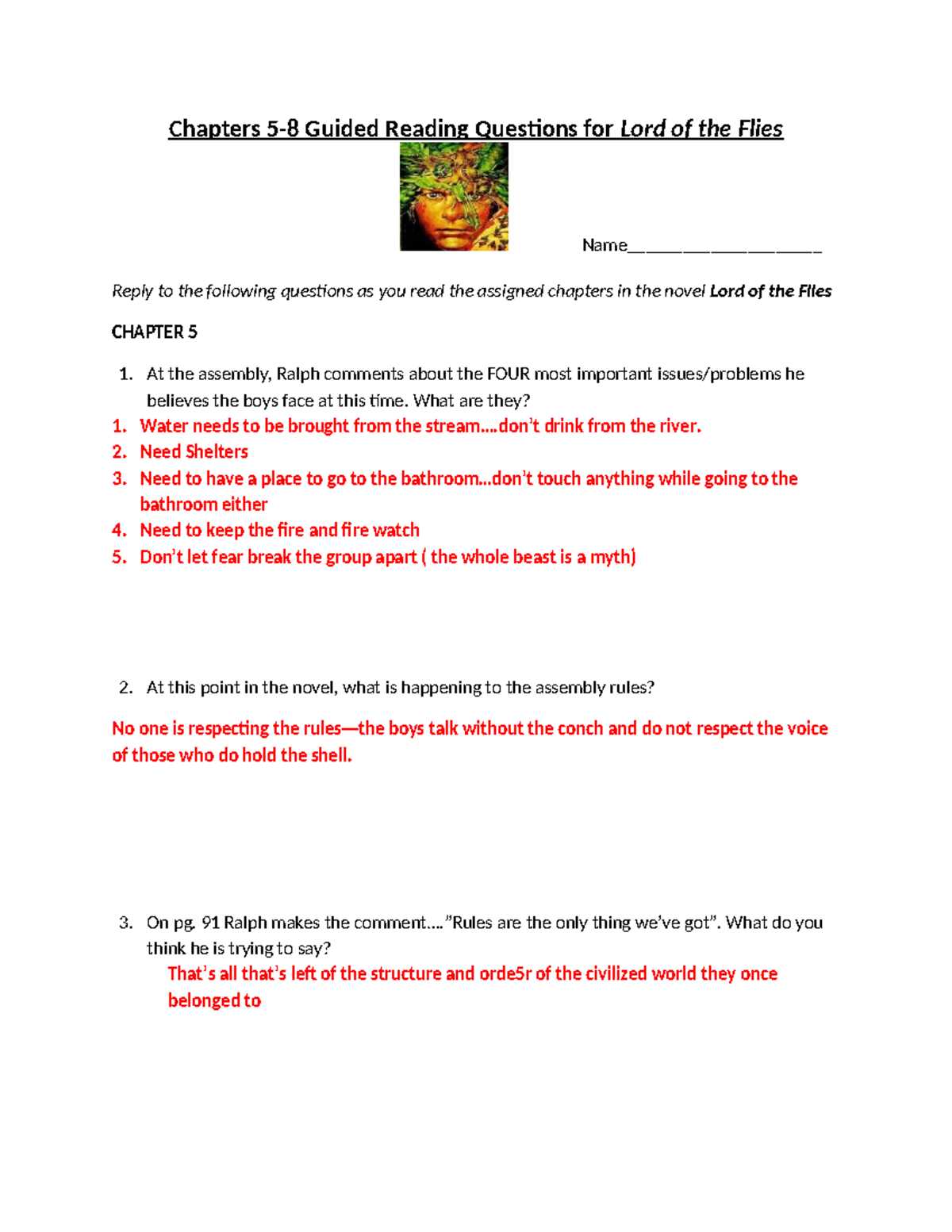
In this section, we delve into critical moments that shape the unfolding narrative. The events reveal deeper struggles, inner conflicts, and evolving dynamics within the group. Each occurrence reflects broader themes of survival, power, and fear that resonate throughout the story.
As we analyze the pivotal scenes, we focus on character development and how their actions influence the group’s direction. Through careful reflection, we also uncover the symbolic elements that enrich the narrative, adding layers of meaning that enhance understanding of the text.
By examining key interactions and their implications, we aim to uncover hidden motivations and themes. This exploration provides valuable insights into how characters confront their fears, establish authority, and navigate complex relationships in an isolated environment.
Key Insights from Chapter 5
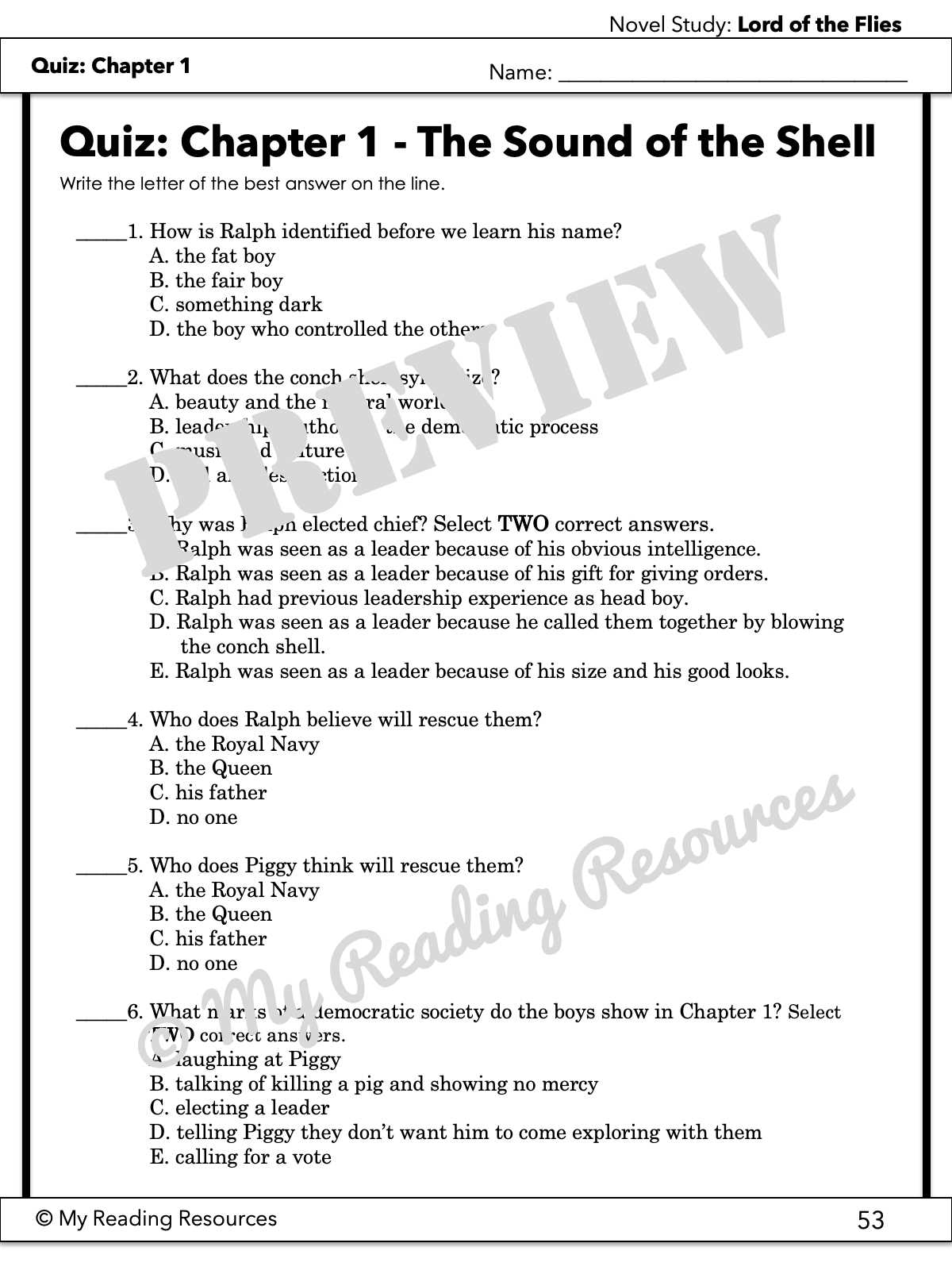
This section examines significant events that shape the progression of the story. Through dialogue, actions, and decisions, we uncover deeper layers of conflict and tension among the characters. These moments reflect the core struggles of power, survival, and morality that define the narrative.
Ralph’s Leadership Struggles
As tension rises, Ralph faces increasing challenges in maintaining order. His attempts to lead are tested by fear, dissent, and his own growing doubts about the group’s unity. The boys’ reluctance to follow rules exposes the fragile nature of authority and control on the island.
Fear of the Beast
The fear of an unseen creature becomes a central theme, influencing the group’s behavior. The boys’ imaginations run wild, fueling paranoia and division. This irrational fear plays a key role in unraveling the fragile sense of civility they once shared.
Key Events in Chapter 5

This section highlights the pivotal moments that drive the narrative forward, showcasing how fear, power struggles, and leadership affect the group dynamics. These events demonstrate the growing disintegration of order and the increasing dominance of primal instincts among the boys.
- Ralph’s attempt to restore order during the meeting
- Piggy’s plea for reason and the importance of the conch
- The boys’ escalating fear of the beast and its impact on their behavior
- Jack’s challenge to Ralph’s authority and leadership
- The breakdown of rational thought as fear takes over
These events are crucial in understanding the deterioration of the group’s unity, as each decision and action leads them further from civility and closer to chaos. The boys’ shifting focus from cooperation to division reflects the overarching themes of civilization versus savagery.
Character Analysis of Ralph
Ralph emerges as a central figure whose actions and choices heavily influence the group’s direction. Throughout the narrative, he struggles to maintain control and unity, constantly challenged by external factors and internal conflicts. His leadership represents order, responsibility, and a desire for civilization in the face of growing chaos.
Ralph’s Leadership and Struggles
Initially, Ralph is elected as the leader, symbolizing hope for structure and stability. However, his ability to govern begins to weaken as fear and dissent spread. Despite his efforts to uphold rules and foster cooperation, the growing divide between reason and irrationality tests his authority. Ralph’s inner turmoil and frustration become more evident as the group’s unity disintegrates.
Conflict Between Rationality and Emotion
Ralph is caught between the need for logic and the overpowering emotions of the other boys, especially as their fear intensifies. His growing frustration reflects his struggle to balance the ideals of civilization with the primal instincts that increasingly dominate the island. His internal conflict is central to understanding his character arc, highlighting the tension between maintaining order and yielding to chaos.
Understanding Piggy’s Role in Chapter 5
Piggy plays a crucial part in the unfolding events, acting as the voice of reason and logic amid growing chaos. His intellect and reliance on rational thought stand in stark contrast to the rising fear and emotional volatility of the other boys. Despite his physical limitations, Piggy’s contributions become central to understanding the group’s descent into disorder.
Throughout this section, Piggy attempts to restore a sense of order, often using the conch as a symbol of authority and communication. His appeals for reason, however, are met with increasing resistance. The boys’ fear of an imagined creature, the beast, undermines Piggy’s attempts to maintain civility, illustrating the tension between intellect and irrationality.
Even though Piggy is marginalized and often ridiculed, his role remains essential to the narrative. His ideas reflect the struggle to preserve civilization in the face of mounting savagery, and his character serves as a reminder of the fragile nature of societal order.
The Significance of the Beast
The figure of an unseen creature looms large in the boys’ minds, serving as a focal point for fear and anxiety. It becomes more than just a myth or imagined threat–it evolves into a powerful symbol that shapes the group’s actions and decisions. The beast represents the darker, primal instincts within each individual, emerging as a manifestation of their growing fears and loss of control.
The Beast as a Symbol of Fear
The beast’s significance lies in its ability to evoke irrational fear, causing the boys to abandon reason in favor of superstition. As the fear of the unknown grows, so does the division within the group. It is no longer merely a matter of survival, but a battle between civilization and chaos, rational thought and emotional impulse.
Fear of the Beast’s Impact on Leadership
As fear spreads, leadership is tested. Ralph’s authority weakens, while Jack’s appeal to the primal instincts of the boys strengthens. The beast drives a wedge between the characters, influencing their relationships and ultimately shaping the future of the group.
| Character | Response to Fear | Impact on Group Dynamics |
|---|---|---|
| Ralph | Attempts to maintain order through logic | Struggles to retain control as fear undermines his leadership |
| Piggy | Focuses on rational thought and explanation | Is ignored as fear overrides reason |
| Jack | Uses fear to manipulate and gain power | Strengthens his leadership by exploiting the boys’ fears |
Ultimately, the beast’s influence reveals the fragility of civilization, as it taps into the boys’ deepest anxieties. Its power lies not in its physical form, but in the way it controls the collective psyche, pushing the boys further away from rational thought and into chaos.
Conflict Between Ralph and Jack
The growing tension between Ralph and Jack is one of the central conflicts in the story. While both characters are driven by different visions of leadership and survival, their clash highlights the broader themes of civilization versus savagery. As the group faces increasing fear and disorder, their rivalry becomes more pronounced, shaping the group’s future direction.
Differences in Leadership
Ralph represents order, reason, and the desire to maintain structure, while Jack embodies the impulse for power and freedom from constraints. Their contrasting leadership styles lead to frequent confrontations, each believing that their approach is the best for the group’s survival.
- Ralph values organization and prioritizes building shelters and keeping the fire going.
- Jack focuses on hunting and gaining control over the boys by appealing to their primal instincts.
- Ralph tries to maintain civility and cooperation, while Jack exploits fear to increase his influence.
Escalating Tensions
As the group’s fear of the beast grows, Ralph and Jack’s differences intensify. Jack increasingly challenges Ralph’s authority, undermining his decisions and creating division among the boys. This escalating conflict reflects the broader breakdown of social order on the island, with each boy choosing sides in the struggle between civilization and savagery.
- Ralph’s attempts to remind the boys of their responsibilities clash with Jack’s desire to embrace freedom and abandon rules.
- The division over leadership grows when Jack openly defies Ralph’s orders, appealing to the boys’ desire for power.
- Ultimately, Jack’s rebellion leads to the fracturing of the group, with many boys choosing to follow Jack’s more aggressive, unrestrained style of leadership.
This ongoing conflict between Ralph and Jack sets the stage for the deeper struggles within the group, highlighting how power and fear can shape the course of events in a society on the brink of collapse.
Exploring the Symbolism of the Conch
The conch serves as a powerful symbol throughout the narrative, representing order, authority, and civilization. Initially, it holds significant value as a tool for communication and control, ensuring that every member of the group has a voice. However, as chaos grows, the conch’s influence wanes, reflecting the gradual breakdown of societal norms on the island.
Initial Significance of the Conch

At the beginning, the conch is a symbol of unity and structure. It is used to call meetings and give individuals the right to speak, establishing a sense of equality and cooperation among the boys.
- The conch represents Ralph’s authority and leadership.
- It is used as a tool for maintaining order during gatherings.
- Its sound signals the hope of keeping civilization intact.
The Decline of the Conch’s Power
As the boys descend further into savagery, the conch begins to lose its importance. The rise of fear, individualism, and Jack’s increasing control over the group lead to a disregard for the conch’s authority. Its eventual destruction marks the complete collapse of order and the triumph of chaos.
- With Jack’s defiance, the conch’s symbolic power begins to fade.
- As fear takes over, the boys begin to ignore its call, signaling the decline of rationality.
- The final destruction of the conch signifies the total disintegration of the group’s societal structure.
The conch’s transformation from a symbol of order to a mere object of disregard illustrates the fragile nature of civilization. Its eventual destruction reflects the triumph of primal instincts over reason, marking a key moment in the story’s exploration of humanity’s darker side.
The Role of Fear in the Chapter
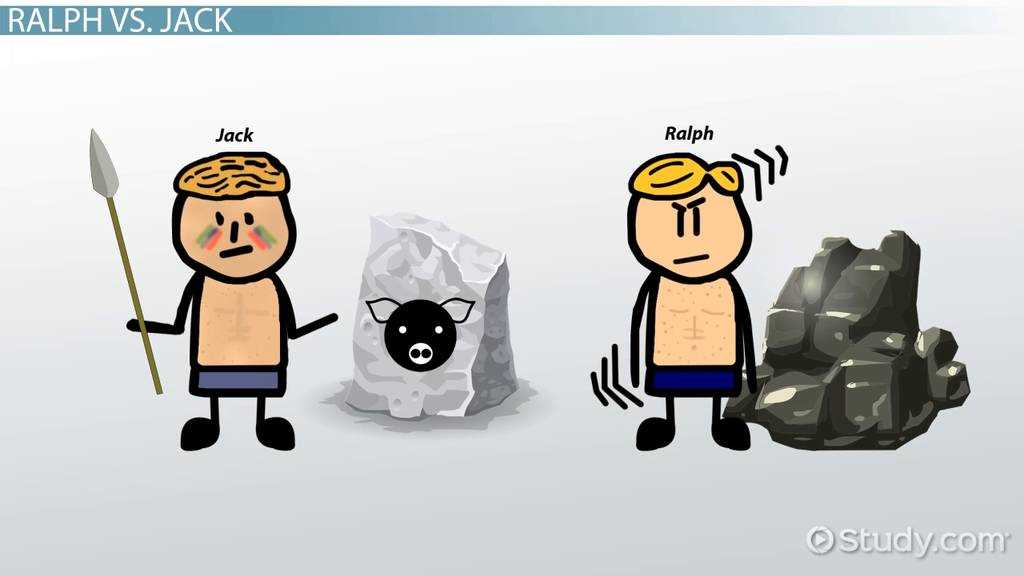
Fear plays a central role in shaping the events and characters throughout the section. It acts as both a motivator and a destructive force, influencing the decisions of the boys and the dynamics within the group. As fear spreads, it becomes an uncontrollable force that undermines reason and order, ultimately leading to greater chaos and division.
Fear as a Driving Force
In this section, fear becomes the primary factor driving the boys’ actions. The imagined presence of a “beast” amplifies their anxiety, leading them to abandon rational thought and focus on survival instincts. This fear is not only of the unknown but also of losing control, as the boys realize that their society is becoming increasingly fragile.
| Character | Response to Fear | Effect on Group |
|---|---|---|
| Ralph | Attempts to maintain order through reason | His authority begins to weaken as fear undermines his leadership |
| Jack | Exploits fear to gain power and control | Uses fear to manipulate others and form a more aggressive faction |
| Piggy | Attempts to explain fear logically | His reasoning is disregarded as fear takes precedence over logic |
Fear’s Impact on Relationships
The rising panic also strains the relationships among the boys. As fear spreads, trust and cooperation erode. The boys become increasingly divided between those who fear the unknown and those who exploit that fear for power. This division highlights the destructive potential of fear, which fuels violence, suspicion, and chaos within the group.
Ultimately, fear in this section serves as a catalyst for the unraveling of order, pushing the boys further away from civilization and toward savagery. Its influence grows stronger as reason weakens, making it a key force in the story’s progression.
How the Boys Perceive the World
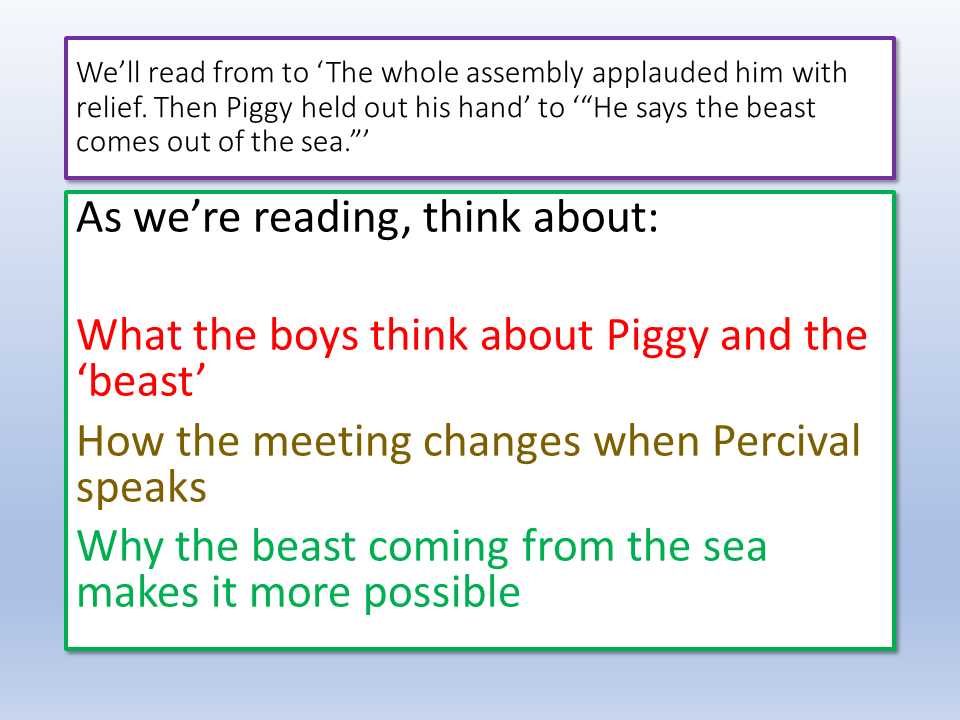
The boys’ view of their environment evolves throughout the story, influenced by fear, isolation, and the breakdown of order. In the beginning, they see the island as a place of opportunity, but as their situation becomes more dire, their perceptions shift toward a darker, more chaotic understanding of the world around them. Their interpretation of events and surroundings reflects their inner struggles and the growing division between civility and savagery.
| Character | Perception of Environment | Impact on Actions |
|---|---|---|
| Ralph | Views the island as a place to maintain order and hope | Focuses on building shelters and maintaining the fire to ensure rescue |
| Jack | Sees the island as a place to dominate and hunt | Embraces violence and chaos, using fear to gain control |
| Piggy | Perceives the world through reason, seeking knowledge and logic | Attempts to maintain rationality, but struggles to have his voice heard |
| Simon | Sees the island as a place of spiritual significance | Retreats into nature, sensing the darkness within the boys themselves |
The boys’ perceptions of their surroundings are influenced by their growing fear and the deepening conflict between their desires for order versus freedom. While some, like Ralph and Piggy, strive to maintain a rational understanding of the world, others, like Jack, embrace the primal forces that the island seems to stir in them. This contrast highlights the underlying theme of the loss of innocence and the descent into barbarism.
The Changing Dynamics of the Group
As the boys struggle to survive on the island, the group’s structure begins to shift, revealing the growing rifts between different individuals and factions. Initially, they work together with a shared goal of being rescued, but over time, divisions form, driven by fear, power struggles, and differing values. This transformation highlights how quickly unity can dissolve in the face of chaos and fear.
Emerging Divisions Within the Group
As tensions rise, individuals begin to splinter off from the original group. Some, like Ralph and Piggy, continue to emphasize cooperation and civility, while others, particularly Jack, gravitate toward more primal instincts, prioritizing hunting and dominance over collaboration. These growing divisions reflect a deeper struggle for control and leadership, with each member interpreting the world differently.
| Character | Role in Group | Influence on Group Dynamics |
|---|---|---|
| Ralph | Leader striving for order | Pushes for structure and civility, but faces resistance |
| Jack | Leader of hunters, challenger of authority | Encourages rebellion against Ralph, pulling others toward chaos |
| Piggy | Advisor to Ralph | Struggles to maintain logical reasoning, often ignored |
| Simon | Spiritual figure | Withdraws from group conflicts, increasingly isolated |
Power Struggles and Shifting Loyalties
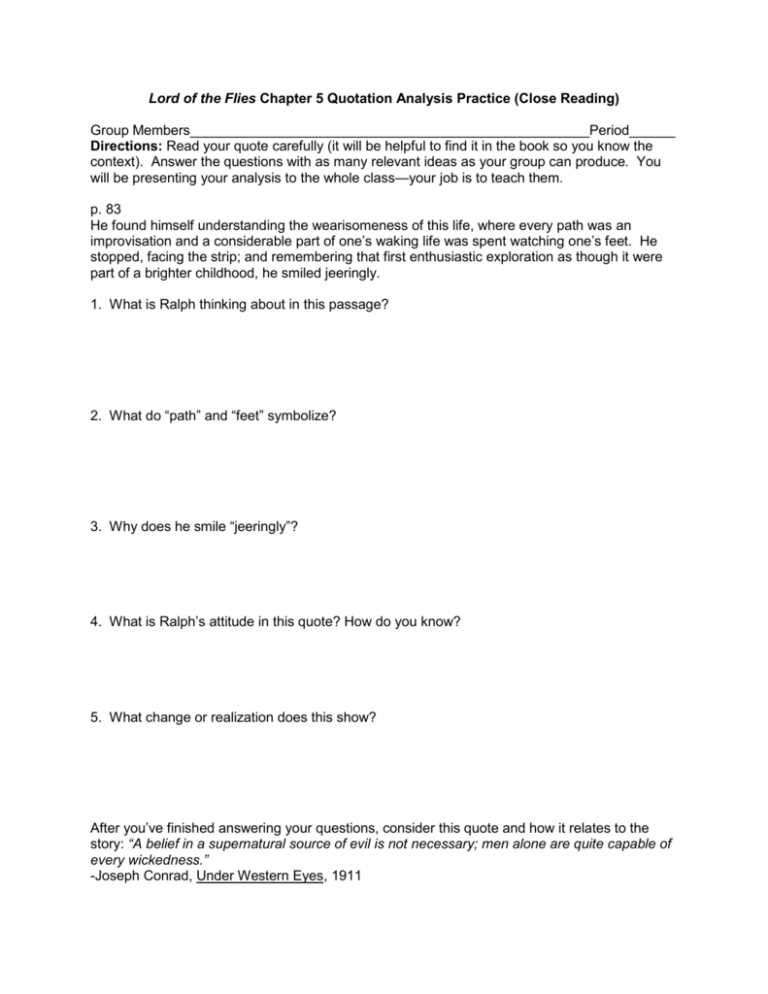
As Jack’s group grows in power, Ralph’s authority weakens. Fear and the promise of safety in numbers drive some boys to switch allegiances. This shift in loyalty further divides the group, with power now resting in the hands of those who embrace fear and aggression, while those who cling to reason are left increasingly marginalized.
The changing dynamics of the group reveal the fragility of social order and how quickly people can abandon unity when faced with fear and uncertainty. What began as a cooperative effort slowly deteriorates into chaos as individual desires for power and control overshadow the group’s original goals.
How the Chapter Highlights Leadership
This part of the story underscores the complexities of leadership, showcasing how different individuals interpret their roles within a group. As tensions rise, we see how leadership styles diverge, with some characters focusing on organization and survival, while others prioritize power and dominance. These contrasting approaches illustrate the challenges of maintaining authority and the impact of leadership decisions on group dynamics.
Ralph’s Struggle for Control
Ralph’s approach to leadership is rooted in rationality and structure. He emphasizes the importance of building shelters and keeping the signal fire going, all with the hope of rescue. However, his leadership faces growing opposition from those who are drawn to Jack’s more authoritarian style. Despite his efforts, Ralph’s ability to lead becomes increasingly challenged as the group’s priorities shift.
Jack’s Authoritarian Leadership
In contrast, Jack’s style of leadership focuses on control through fear and power. His focus on hunting and embracing the island’s primal nature appeals to a growing number of boys who crave excitement and a sense of dominance. Jack’s rise in power highlights how fear and the desire for safety can be powerful tools in leadership, even if they undermine the group’s unity and goals.
The contrasting leadership styles of Ralph and Jack illustrate the tension between reasoned authority and charismatic, fear-driven control. As the narrative progresses, it becomes clear that effective leadership is not simply about holding power, but about balancing the needs of the group while maintaining unity and purpose.
Key Themes in Lord of the Flies
This story explores a range of profound themes that highlight human nature, social order, and the breakdown of civilization. At its core, it examines how individuals respond to isolation and the absence of structured authority. As the narrative unfolds, themes of power, fear, identity, and moral struggle come to the forefront, showcasing the complex relationship between society and individual behavior.
One significant theme is the inherent conflict between civility and savagery. The characters’ descent into primal instincts as they face adversity is a reflection of the tension between society’s rules and the desire for personal freedom. Another key theme revolves around leadership, as characters grapple with authority and control, which ultimately shapes their actions and the fate of the group.
Fear plays a central role in the story, influencing decisions and fostering division within the group. The fear of the unknown, as well as the fear of losing control, pushes individuals to make choices that challenge their morals and beliefs. Additionally, the theme of civilization versus barbarism is explored through the boys’ gradual abandonment of societal norms, revealing how fragile the constructs of law and order truly are.
Why the Fire Becomes a Central Focus
The fire emerges as a symbol of hope and survival, representing the boys’ connection to civilization and their desire to be rescued. In this section of the story, it takes on greater significance as a focal point for the group’s collective efforts. As the boys’ struggle for order intensifies, the fire’s maintenance becomes not just a practical concern, but also a measure of their unity and adherence to societal norms.
Symbol of Hope
The fire serves as the boys’ primary means of signaling for rescue, offering a beacon of hope that someone will notice their distress and bring them back to civilization. It represents their connection to the world beyond the island and their belief that they are not completely isolated. The boys’ commitment to keeping the fire burning is directly tied to their survival instincts and the longing to escape their current predicament.
Conflict Over Priorities
As tensions rise between characters, the fire also becomes a point of conflict. Some members of the group, particularly Ralph, emphasize its importance for survival, while others, led by Jack, grow increasingly focused on hunting and the thrill of power. This growing divide over priorities demonstrates the broader struggle between civility and savagery, with the fire symbolizing the boys’ waning connection to reason and society.
Ultimately, the fire represents both a literal and symbolic lifeline, encapsulating the themes of hope, survival, and the ongoing conflict between order and chaos on the island.
Ralph’s Struggles with Authority
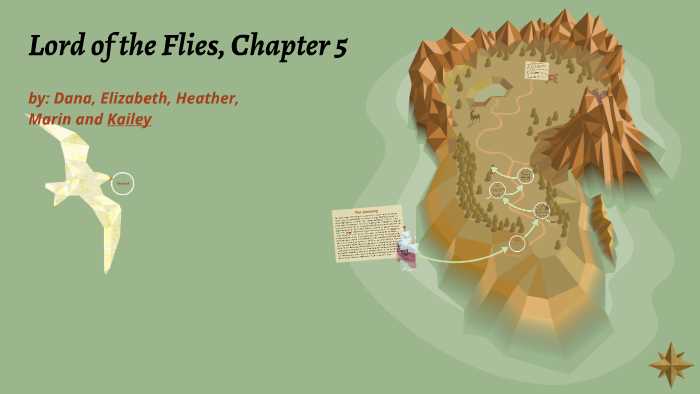
As the leader of the group, Ralph faces numerous challenges in maintaining order and discipline. His role requires him to balance the needs of the group with his own vision of how things should be run, yet he struggles to assert his authority effectively. This conflict arises not only from external forces but also from his internal doubts and the growing opposition from others within the group.
One of the main difficulties Ralph encounters is his inability to control the increasing disarray among the boys. As time passes, the desire for power and freedom leads some, particularly Jack, to challenge Ralph’s leadership. This conflict becomes a pivotal element in the story, reflecting the larger struggle between civilization and primal instincts.
Internal Conflict
Ralph’s internal struggle is a key aspect of his leadership challenges. He understands the importance of maintaining order, yet he begins to question his ability to keep the group united in the face of mounting chaos. His self-doubt is compounded by the increasing frustration of the boys, particularly when they ignore his directives or rebel against his decisions.
Opposition from Jack
Jack’s opposition to Ralph’s authority exacerbates the tension within the group. While Ralph tries to foster cooperation and mutual respect, Jack focuses on his own growing power and the desire for dominance. This conflict between the two leaders represents the broader theme of the conflict between civilization and barbarism, as Jack’s focus shifts to hunting and violence, while Ralph remains committed to the ideals of rescue and order.
Ultimately, Ralph’s struggles with authority illustrate the difficulty of leadership in a situation where the rules of society are breaking down and personal ambitions begin to overpower collective needs.
The Impact of Isolation on the Boys

As the days go by, the boys’ isolation from the adult world takes a toll on their behavior and mental states. Being cut off from society and the structure it provides leads to a gradual breakdown of order and civility. Without any external authority, the boys begin to grapple with their own instincts, causing an increasing sense of chaos and fear among them.
Isolation plays a significant role in unraveling the group’s unity. The absence of rules and supervision allows darker emotions to surface, leading to conflict, fear, and even violence. With no adults to guide them, the boys’ survival instincts begin to dominate their actions, revealing the complex nature of human behavior when stripped of societal norms.
Loss of Structure
Without any external structure to adhere to, the boys start to lose a sense of purpose. The routines they once followed begin to break down, and the group’s decision-making becomes less rational. As their isolation stretches on, their dependency on each other grows, but so does their sense of frustration and helplessness. Ralph tries to keep the group organized, but the absence of external consequences for bad behavior makes it harder for him to maintain control.
Fear and Paranoia
Fear becomes one of the primary emotional responses to isolation. The boys’ imaginations run wild as they begin to believe in supernatural threats, like the “beast,” that they think lurks on the island. This collective fear heightens their paranoia and divisions within the group. In their vulnerable state, they are more susceptible to manipulations and their own worst fears, which only deepen the isolation they feel.
The long-term effects of isolation transform the boys, revealing how the absence of civilization can rapidly shift behavior from cooperative and rational to primal and chaotic.
?
How Chapter 5 Sets Up Future Events
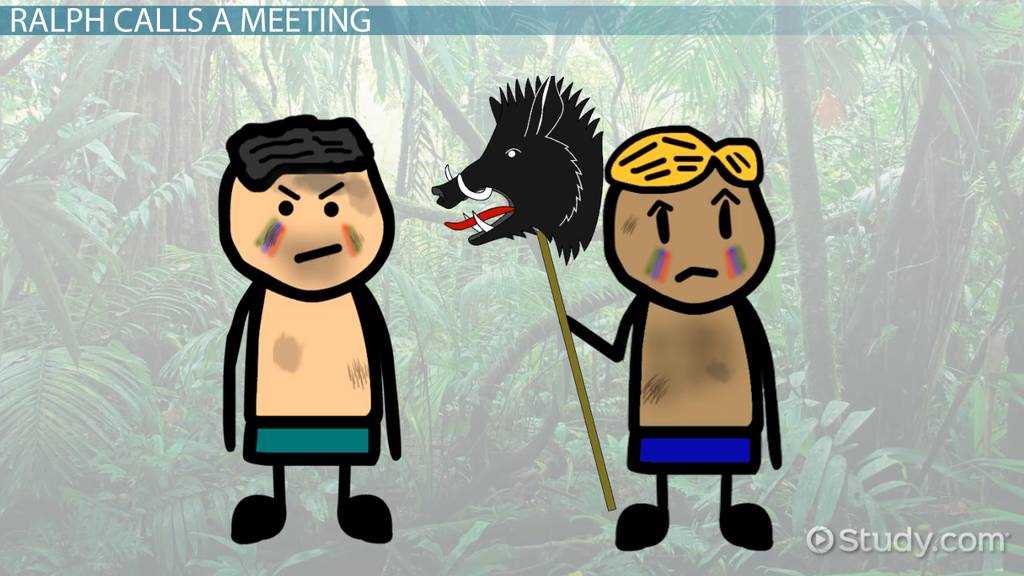
In this section, several pivotal moments unfold that shape the trajectory of what happens next in the story. Key conflicts are established, motivations become clearer, and underlying tensions emerge, all of which create the foundation for future developments. The events are not only critical for understanding character evolution but also for foreshadowing the struggles that lie ahead for the group.
Emergence of Fear and Paranoia
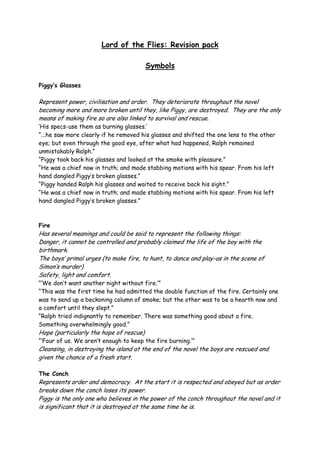
The fear of an unknown force begins to take root among the group, setting the stage for irrational behavior in subsequent sections. This fear, whether real or imagined, becomes a driving force that affects the decisions and actions of the boys. It hints at the disintegration of order and the rise of chaos.
Leadership Struggles Intensify
As authority continues to clash, the tension between Ralph’s rational approach and Jack’s more primal leadership style begins to deepen. This ongoing struggle over control becomes a central theme, influencing how the boys will interact with each other moving forward.
- The escalation of power struggles between Ralph and Jack creates a volatile environment.
- The boys’ growing fear of the “beast” signals a shift towards superstition and violence.
- Decisions made in this section foreshadow the eventual fracturing of the group.
These developments in the current section provide a critical lens through which to view the breakdown of civilization and the boys’ descent into savagery. Each choice and action laid the groundwork for the increasingly dire circumstances that will unfold.